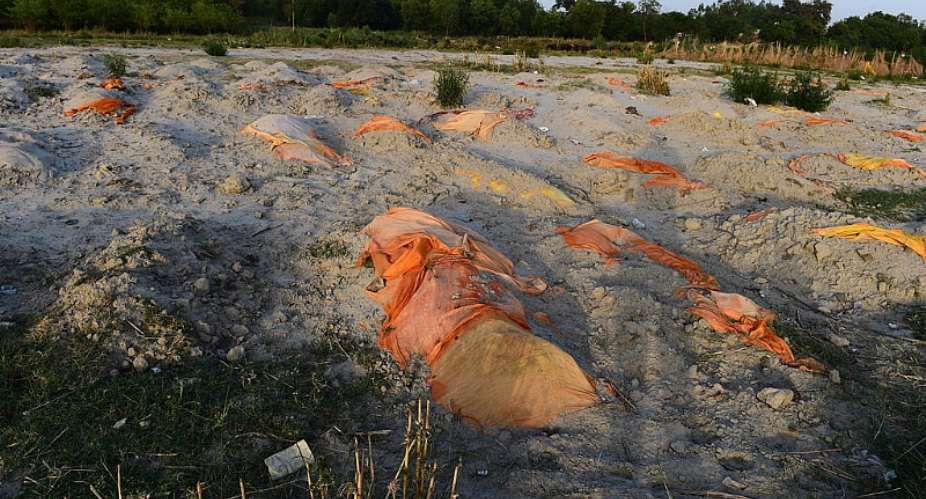The real impact of India's Covid-19 surge on rural areas has begun to emerge thanks to vernacular media journalists reporting from the devastated countryside, where 70 percent of the population of 1.4 billion people live.
Using journalism's oldest tools, journalists have been unravelling firsthand the scale of the havoc in many of India's 650,000 villages where a highly infectious strain of the coronavirus has spread.
“These are reporters without fear,” media analyst Shivaji Sarkar, with Mangalayatan University, told RFI. “Freelance journalists in small towns are the backbone of vernacular newsrooms and it is they who are at the front-lines now. Kudos to them."
Coronavirus has killed 266,000 people and infected 24 million by a latest official tally in the world's second worst-affected country.
Grisly spot
Dainik Bhaskar, India's largest-selling Hindi language newspaper, knocked on the doors of villagers in agrarian states to try to reveal the full story.
“Almost every home has people with flu or a cough and their only hope are doctors,” it reported from Rajasthan's Nagaur district.
The daily said 31 of 49 people in three Nagaur hamlets died without being tested for Covid.
Nav Bharat Times, published a similar report from Uttar Pradesh, India's most populous state.
“Most homes in four districts have people with Covid-like symptoms but they have neither been tested nor treated,” the mass-circulation Hindi daily added.
Jansatta, another vernacular broadsheet, had a similar story from Uttar Pradesh, where Covid has killed 16,369 people, according to an official count.
In Gujarat, Prime Minster Narendra Modi's home-state, reporters from Sandesh keeping tabs on deaths in hospitals and those cremated around local cities said the figures did not tally.
Covid deaths were largely under-reported, the leading Gujarati-language paper said, giving dates, numbers and details in a tell-all news dispatch.
In Bihar state, intrepid journalists published what they asserted were verified photographs of hospital staff dumping infected bodies into a river.
In contrast, English-language national newspapers faced criticism for not doing enough to call out India's rural misery.
Analysts such as Sarkar said media groups eager to grab state advertisements appeared reluctant to report the extent of the catastrophe.
The federal government daily spends more than 222,000 euros on publicity while India's 29 states too have deep pockets for self-promotion.
'Armchair journalism'
“Major parts of the Indian media have abdicated their oversight duty at every stage of the Covid-19 saga over the last year,” said Policy Times, an online publication.
Anupama Jha, a former executive director of Transparency International's Indian arm said English-language papers seemed content reporting only the urban crisis.
“Journalists in the metros lack the sensitivity and I also feel they do not want to get on the wrong side of the government,” she told RFI, warning that “armchair journalism” was useless at a time of the pandemic.
India has drawn criticism for its inability to counter the deadly surge or vaccinate a sizable chunk of its population in time.
Global donors rushed aid following news reports of oxygen and medical shortages killing people in city hospitals but not much of the handouts have reached the impoverished countryside.





 EC’s request to use Ghana Card as sole document for identification would’ve prev...
EC’s request to use Ghana Card as sole document for identification would’ve prev...
 Voter registration: Always check to avoid 2020 election results errors — Kwamena...
Voter registration: Always check to avoid 2020 election results errors — Kwamena...
 Voter registration: Ghana isn't safe; December polls might be 'each one for hims...
Voter registration: Ghana isn't safe; December polls might be 'each one for hims...
 Rapid decline of our country, its democratic institutions worrying, distressing ...
Rapid decline of our country, its democratic institutions worrying, distressing ...
 Religious tolerance: My brothers and sisters are Christians, I cannot say that I...
Religious tolerance: My brothers and sisters are Christians, I cannot say that I...
 CSOs consider civil action against gov't over alleged destruction of protected f...
CSOs consider civil action against gov't over alleged destruction of protected f...
 Domelevo, Kpebu, Gyampo and 83 others petition parliament to probe EOCO’s conduc...
Domelevo, Kpebu, Gyampo and 83 others petition parliament to probe EOCO’s conduc...
 “Take precaution, don’t be in a hurry to go and die” — Author advise drivers, pe...
“Take precaution, don’t be in a hurry to go and die” — Author advise drivers, pe...
 Electoral Commission has been reduced to 'Error Commission' in simple arithmetic...
Electoral Commission has been reduced to 'Error Commission' in simple arithmetic...
 Banking clean-up helped prevent collapse of financial sector – Bawumia
Banking clean-up helped prevent collapse of financial sector – Bawumia
